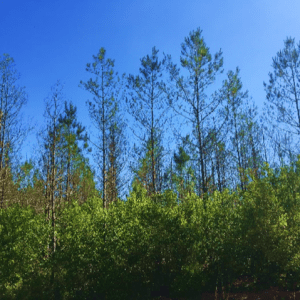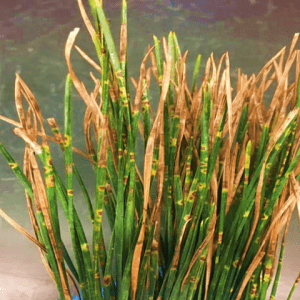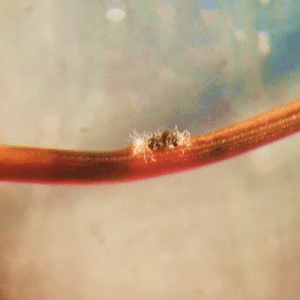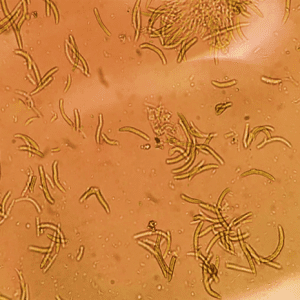Forestry

Brown spot needle blight is an emerging disease in loblolly pine plantations in Alabama. Identification and control of this fungus is crucial for the survival of this native species.
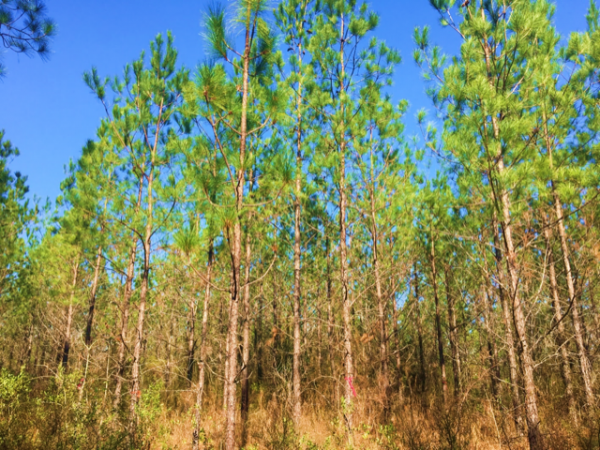
Figure 1. Loblolly pine is adaptable to many types of soil and growing conditions from central Texas east to Florida and north to Delaware and southern New Jersey.
Brown spot needle blight is a native disease caused by the fungus Lecanosticta acicola (Mycosphaerella dearnessii, syn. Scirrhia acicola). First reported in South Carolina in 1878, this fungal pathogen is known for causing needle shed and stunted growth in many pine species (Pinus spp.). Recently the disease has become an important problem of loblolly pine plantations in Alabama.
Loblolly pine (Pinus taeda) is one of the most productive pine species native to the southeastern United States. Approximately 29 million acres of loblolly pine plantations exist in this region. Over the past 3 years, however, premature needle defoliation followed by tree mortality has occurred.
More than 1,000 hectares of loblolly pine plantations in Alabama are currently infected with brown spot needle blight that has caused stunted growth and tree mortality. The identification and control of this emerging disease is an important concern to landowners, forest managers, and forest health state cooperators.
Diagnosis and Identification
Brown spot fungi, L. acicola, complete their life cycles on pine needles. Infection causes needle chlorosis (yellowing) followed by necrosis (dead needles), which results in premature shedding of needles, reduced growth, and tree mortality.
Infections and visible symptoms occur from late February to early November. There are two distinct types of necrotic lesions observed on infected needles. The most notable symptom is an irregular brown spot surrounded by a yellow halo. In some cases, the yellow tissue can be infiltrated with resin. The second type of lesion is a spot that is initially yellow but browns over time and is surrounded by a darker border. This symptom is similar to a different fungal disease called “red band” or Dothistroma needle blight. Symptomology additionally can mimic abiotic factors, such as chloroflurocarbon or sulphur dioxide exposure, as well as deficiencies in nutrients such as magnesium and potassium.
Symptoms must be verified with laboratory diagnosis at facilities such as the Forest Health Dynamics Laboratory (FHDL) at Auburn University. Identification is reliable only when evidence of the characteristic conidia of the anamorphic state (L. acicola) is recovered in culture and/or identified using molecular methods.
- Figure 2a. Disease symptoms showing stands infected by brown spot needle blight (note the thinning canopies).
- Figure2b. Disease symptoms showing irregular, frequent brown spots surrounded by a yellow halo.
- Figure 2c. Reproductive structures showing black, shiny fruiting body protruding from needles.
- Figure 2d. Reproductive structures showing microscopic banana-shaped septate conidia.
Control and Management Guidelines
Foliar chemical treatments are available; however, the most successful steps for disease control are based on the host, environmental conditions, and precautions taken during plantation establishment.
Prevention
Not all loblolly pine families are equally susceptible to the disease. Selecting seedlings resistant to brown spot needle blight infection will decrease the chance of infection after outplanting in the field.
Cultural Control and Sanitary Methods in Landscape Settings
The fungus is most active during warm (62 to 82 degrees F) and wet (humidity greater than 80 percent) conditions. Increasing spacing between seedlings allows air circulation to minimize infection. The pruning of lower branches also can be helpful in increasing air circulation.
Monocultures of loblolly pines are at greatest risk. Consider planting a mixture of pines (such as shortleaf or longleaf) to prevent the spread of infection and potential mortality to all landscape trees.
Replace weeds and grasses under the trees with a layer of composted mulch to prevent plant competition and mower damage and also to improve tree vigor. Apply mulch 3 to 4 inches deep, ideally extending to the tree’s dripline.
Cultural Control and Sanitary Methods in Forest Settings
Visually inspect tree crowns in forest settings for brown spot needle blight severity. This can be done by visually rating the proportion of tree crown with yellowing, dead needles and/or by examining the extent of the thinning crown. Another visual inspection method is to evaluate the progression of the disease from the pine’s lowest branches to the uppermost part of the tree.
Selective removal of infected branches can be a promising solution when less than one-third of the tree crown is infected and the disease is detected only on the lower branches. This may reduce pathogen pressure or fungal loads of L. acicola of an infected stand. Prune during dry summer periods and sanitize tools after each tree pruning to prevent pathogen spread.
If two-thirds or more of the crown is infected, whole tree removal is recommended. Fell and burn infected trees along with any litter under the trees. If 50 percent of trees in a stand are infected, clear-cutting the stand and regenerating the stand is recommended.
No fungicides are recommended in an established setting due to the cost as well as negative environmental factors associated with the use of chemicals.
Chemical Control
Fungicide treatments are effective in protecting pine seedlings from infection by L. acicola. In nursery settings, chlorothalonil or maneb broad-spectrum fungicides (e.g., Bravo and Daconil) can be sprayed to provide successful control against brown spot infection. Another option is a Bordeaux mixture composed of copper sulfate and slaked lime; this adds a protective barrier on the plant surface that inhibits conidial germination. This product can be used for the protection of landscape seedlings, seed orchard trees, and Christmas tree plantations.
It is best to initiate spraying in the spring when newly emerging needles are 2 to 5 centimeters long. Four to six applications throughout the year are usually sufficient for adequate control. Preventative fungicide treatments also are applicable in the landscape settings of high- value trees. For product rates and recommendations of fungicides, always read and follow product labels.
References
- CABI. 2019. “Mycosphaerella dearnessii (brown spot needle blight).” Invasive Species Compendium. Wallingford, UK: CAB International. www.cabi.org/isc.
- EPPO (European and Mediterranean Plant Protection Organization). 2005. “Mycosphaerella dearnessii.” EPPO Bulletin. Wiley Online Library PM 7/46(1). https://doi.org/10.1111/j.1365-2338.2005.00824.x.
- Siggers, P. V. 1932. “The Brown Spot Needle Blight of Longleaf Pine Seedlings.” J. Forest. 30: 579–593.
- Skilling, D. D., and T. H. Nicholls. 1974. “Brown Spot Needle Disease: Biology and Control in Scotch Pine Plantations.” U.S. Department of Agriculture Forest Service Research paper NC-109: 1–19.
- Van Der Nest, A., M. J. Wingfield, J. Janoušek, and I. Barnes. 2019. “Lecanosticta acicola: A Growing Threat to Expanding Pine Forests and Plantations.” Molecular Plant Pathology 20, no. 10: 1327–1364.
 Debit Datta, Student Employee, Lori Eckhardt, Professor, and Arnold “Beau” Brodbeck, Extension Specialist, all in Forestry, Wildlife, and Natural Resources, Auburn University
Debit Datta, Student Employee, Lori Eckhardt, Professor, and Arnold “Beau” Brodbeck, Extension Specialist, all in Forestry, Wildlife, and Natural Resources, Auburn University
New September 2021, Brown Spot Needle Blight of Loblolly Pine, FOR-2105


